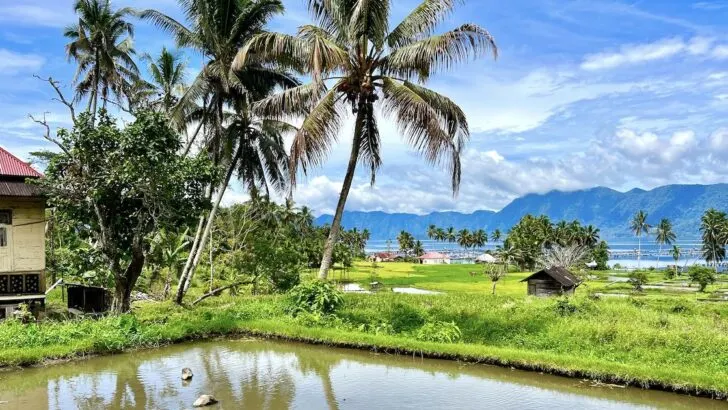How could anyone not feel impressed when they get their first glimpse of Maninjau Lake in West Sumatra?
Formed by a long-ago volcanic eruption, the 52,000-year-old crater lake is surrounded by fishing villages and rice terraces.
Out of all of the places I visited on my Sumatra backpacking itinerary, it surprised me the most.
I travelled to Lake Maninjau under the recommendation of a local in Bukittinggi and spent a couple of nights there, including one full day biking the 50-kilometre road around the lake.
I also visited the Puncak Lawang viewpoint over the lake.
Before I delve into the best places to stay and things to do at the Maninjau crater lake, perhaps you’re looking for more Sumatra guides.
I also have detailed guides for your Lake Toba travel itinerary (North Sumatra), and closer by, a Harau Valley travel guide and a post on the best things to do in Bukittinggi Sumatra.
Disclosure: This post includes affiliate links. If you decide to click through and make a qualifying purchase, I will receive a small commission at no extra cost to you – thanks for your support.
Where is Maninjau Lake?
Maninjau Lake is in the west of Sumatra, the largest island in Indonesia.

The lake is contained within a crater that formed millions of years ago.
It’s around 30 kilometres west of Bukittinggi, the third largest city in West Sumatra.
The nearest airport is Minangkabau International Airport in Padang, which is around a 2.5-hour drive from the crater lake.
Is Maninjau Lake Worth Visiting?
If you want to get off the beaten track, I highly recommend that you visit Lake Maninjau.
As the first President of Sumatra said in his poem, “Do not come to Minang lands if you do not stop at Maninjau.”
The most famous crater lake – the world’s largest, in fact – is Lake Toba in North Sumatra. Therefore, many people don’t bother to visit Maninjau.
However, it has a completely different vibe. It feels smaller, more intimate, and easier to get to know – after all, you can’t bike all the way around Lake Toba, as it’s way too large.
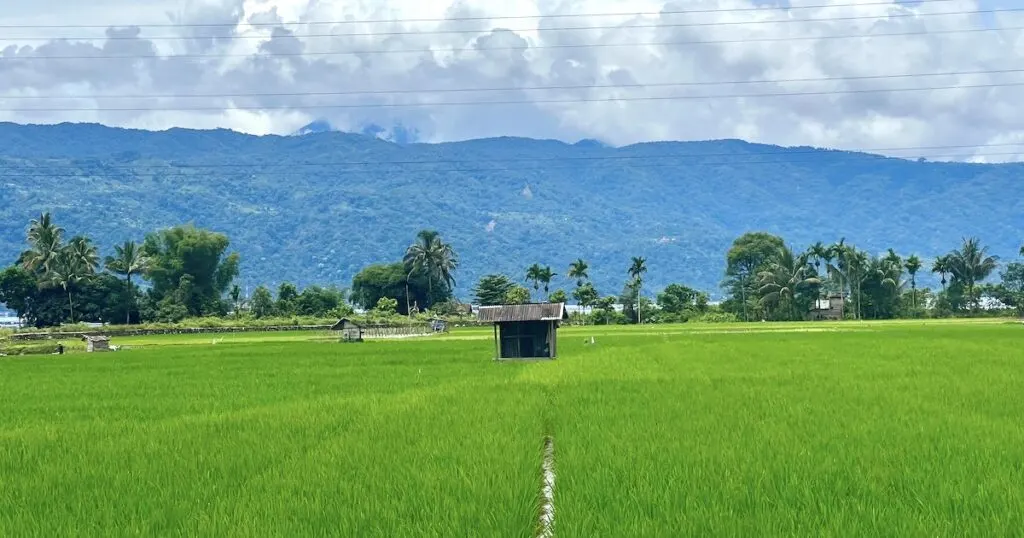
However, don’t get it twisted. You can’t swim at Lake Maninjau.
Instead, you’ll spend most of your time on the shore, either relaxing, exploring the fishing villages, cycling, walking or eating.
If you’re into sketching, painting, or writing, this is the place to do it. There’s inspiration everywhere.

If you’re a backpacker or traveller who prioritises places where you can easily chat to locals, you might also like it.
When I was cycling around the lake, I was happily swarmed by a group of school kids wanting to practise their English. I was also invited by fishermen to try fishing in the lake.

Many villagers were very curious to see two blonde-haired foreigners cycling the length of the lake (especially when rain clouds started brewing) and stopped to chat and ask us questions in bewilderment.
In short, Maninjau is worth visiting for:
- Rest and relaxation.
- Cycling or scooter-ing the 50-kilometre loop.
- Trips to Puncak Lawang, the viewpoint above the lake.
- Eating local food.
- Scenery like mosques, rice paddies, fishing boats, and riverside parks.
A Short History of Maninjau Lake
The crater at Maninjau was formed over 52,000 years ago, although the precise date remains unknown.
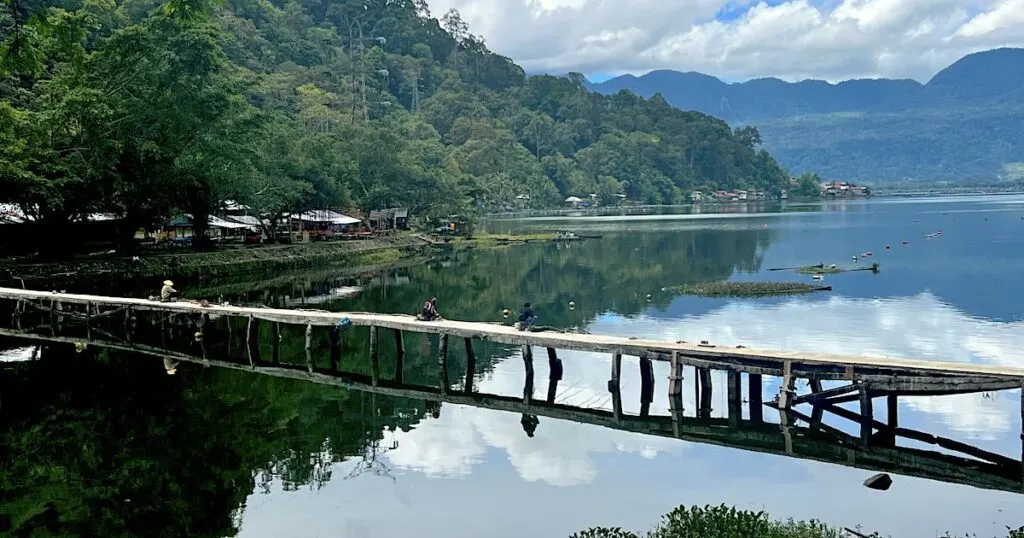
Before 1998, tourists and locals could swim in the lake. Sadly, after a series of natural disasters struck Sumatra, tourism suddenly declined.
The locals had to find other forms of income. Fish farms were set up so that villagers could extract pensi, a small mussel, and palai rinuak, a small fresh fish.

Sadly, the water quality has declined as a result. In the words of a local Bukittinggi man I met, the water will make you ‘itchy’ if you swim.
The main villages around the lake are Maninjau and Bayur, which are predominantly occupied by Minangkabau people.
How to Get to Maninjau Lake
The easiest way to get to Maninjau Lake is to take a bus from Bukittinggi. There are several minibuses every day, but they stop departing in the late afternoon and evening.
I travelled directly from Harau Valley to Maninjau. After taking the local bus from Payakumbuh to Bukittinggi, I was dropped off at a street corner in Bukittinggi where the minivans were waiting.
We haggled a one-way price of 30k per person for four people, down from their initial price of 50k per person.
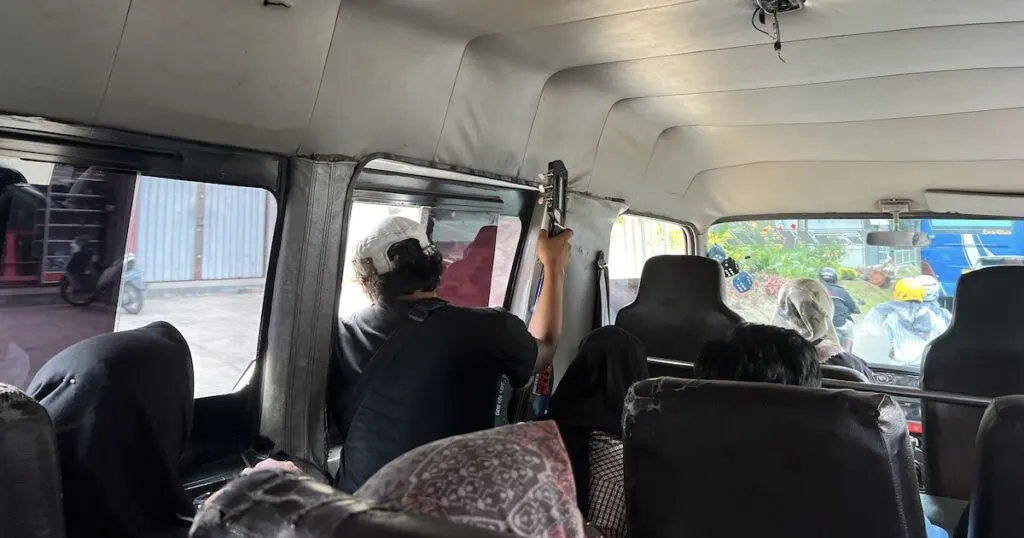
I’ve heard that the local bus, which runs from the Aur Kuning terminal in Bukittinggi, is less expensive (around 15-20k per person).
A private taxi is, of course, the most expensive option.
You can’t travel directly to Maninjau from Padang without taking a taxi. You will need to change buses in Bukittinggi.
How to Get Around Maninjau Lake
1. Scooter
The best way to get around the lake is by scooter. Scooter rental in Maninjau should cost approximately 100k IDR per day.
The main road around the lake is well-kept and mostly flat. There are a few small hills on the western edge.
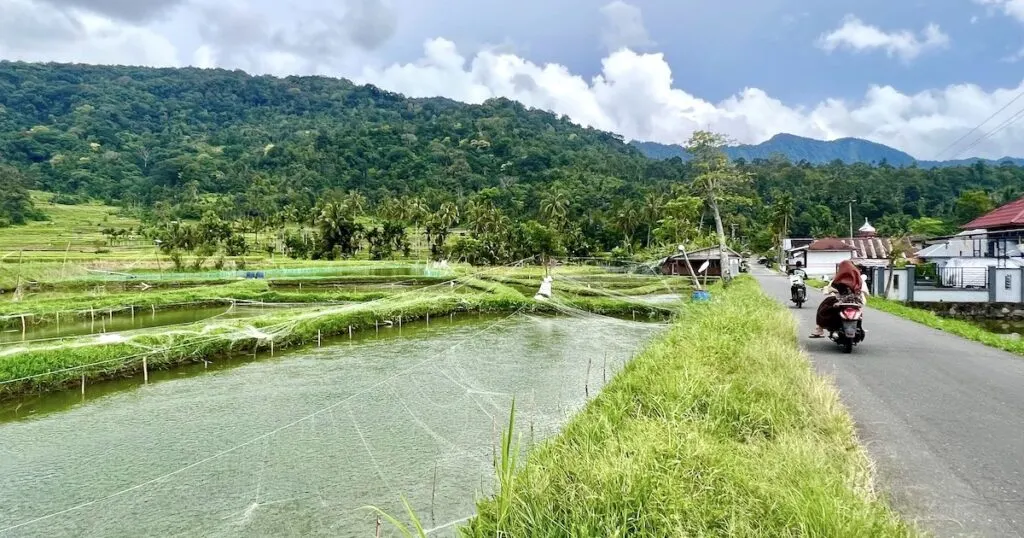
There isn’t much traffic around the lake either, making it safe for cyclists or scooter riders.
2. Pedal bicycle
The road around Maninjau is 50 kilometres long, so it’s possible to cycle around the whole lake in one day.
With several stops along the way and keeping a slow pace, we cycled the length of the lake in around six hours.
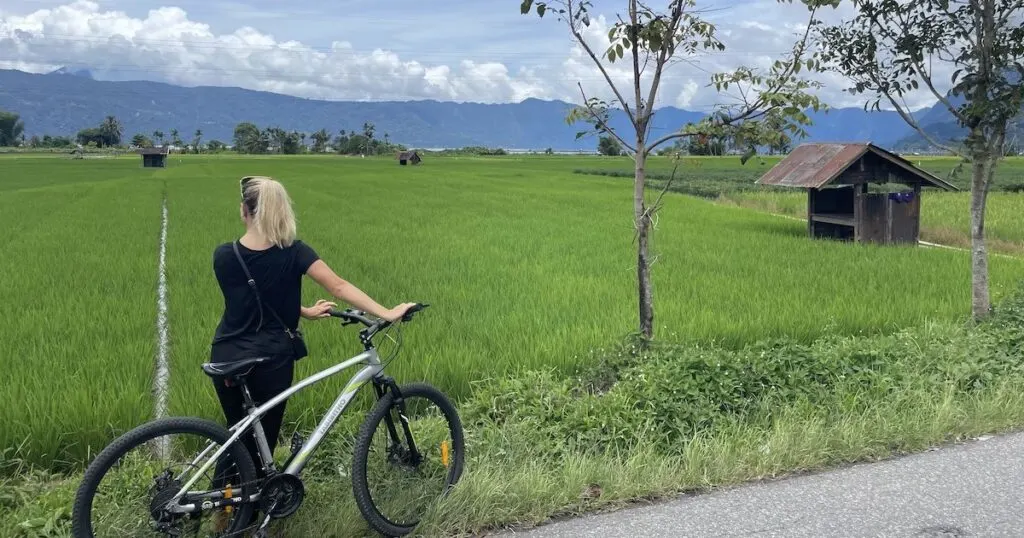
The bicycle is also handy for exploring the immediate area around your accommodation.
Bicycle rental is the most affordable form of transport for the lake. I rented bicycles from Beach Guesthouse for 60k IDR per bicycle.
3. Car
Unless you are already travelling Sumatra with a rental car, travelling to Maninjau by car will require you to pay a taxi.
Taxis are the most expensive option for getting around the lake. A car and driver for the day can cost anywhere between 250k and 300k IDR.
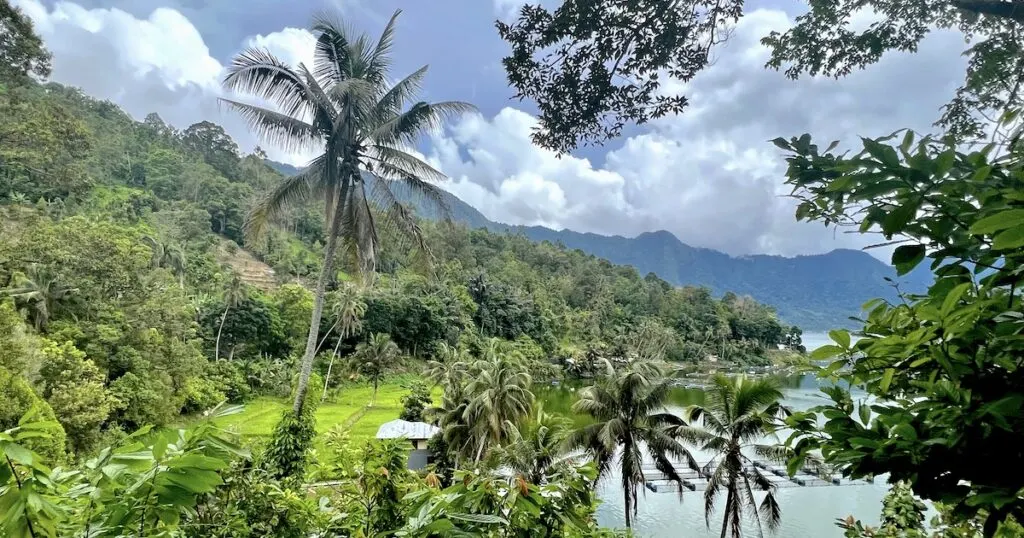
For 300k IDR, you should be able to convince the driver to take you to Puncak Lawang, the viewpoint above the lake.
If you want to include the wider region, a driver and fuel will cost 750k IDR.
Maninjau Lake Hotels: Where to Stay
I stayed at Beach Guesthouse, a simple but scenic guesthouse on the lakeshore. It is in the main village, near to the winding road towards Bukittinggi.
I really liked the lakeside restaurant terrace, where we ate several times. The guesthouse also arranged our bicycle hire and a taxi to Puncak Lawang.
The sunsets were also spectacular, and coincided with the call to prayer reverberating across the lake.
A good alternative is Eka’s Bungalows, previously known as the Muaro Beach Bungalows. Just like Beach Guesthouse, it is located on the lakefront within the main village.
Where to Stay at Maninjau Lake
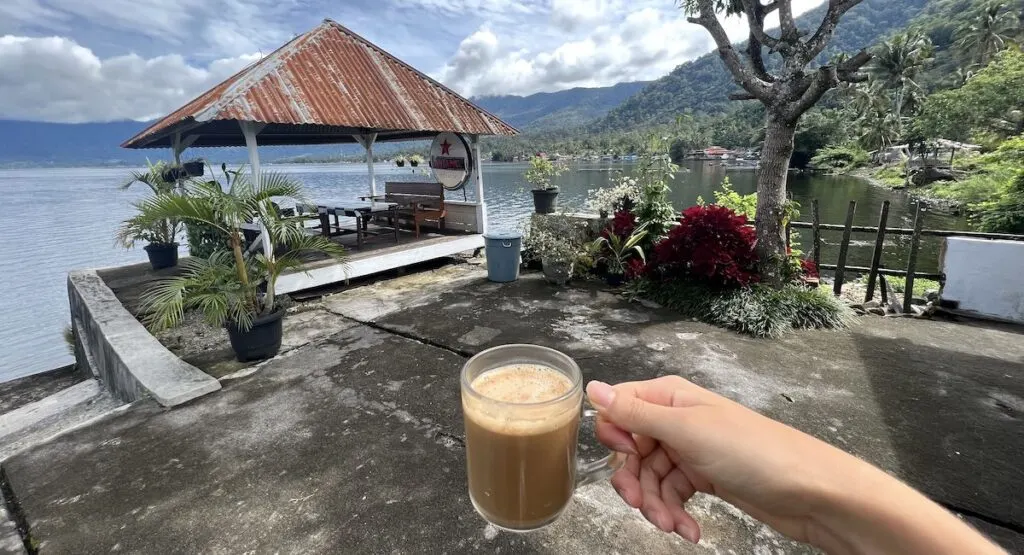
Beach Guesthouse (£££)
I stayed here!
The Best Things to Do at Maninjau Lake
1. Drive down the Kelok 44
Technically, you can’t get to Maninjau Lake without passing through Kelok 44 unless you’re taking a very long route from Padang.
However, it’s still one of the most interesting points along the lake.
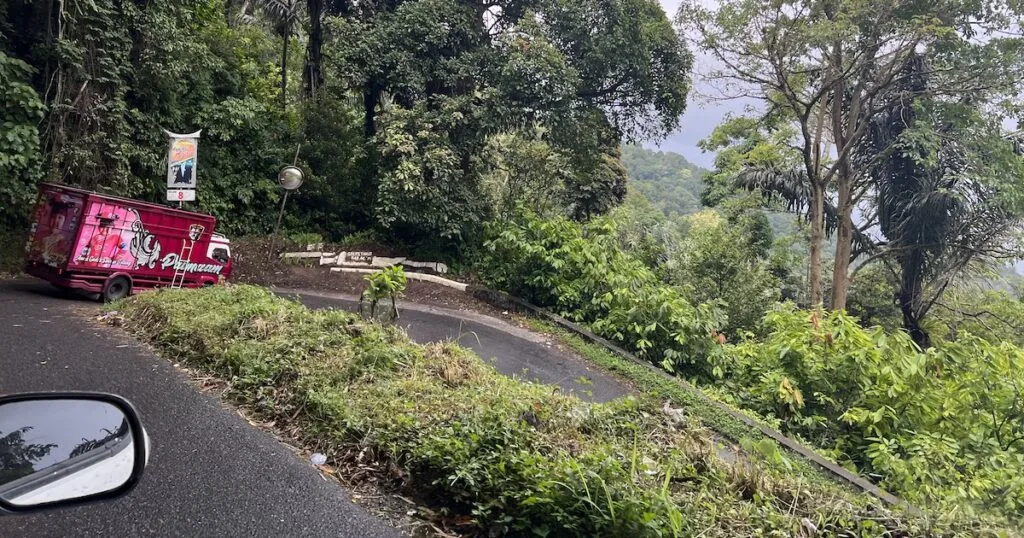
The 44 famous hairpin road bends weave sharply downhill towards the lake.
The higher sections of the road are lined with coffee shops and warungs where you can stop for a drink or meal to enjoy the view over the lake.
2. Cycle the length of the lake
My favourite memory is completing my 50-kilometre loop of the lake. You can do this road by scooter, but cycling lets you slow down and really savour every moment.
The lake is surrounded by paddy fields, fishing villages, mosques and lakeside parks where you can watch the local fishermen in their boats.
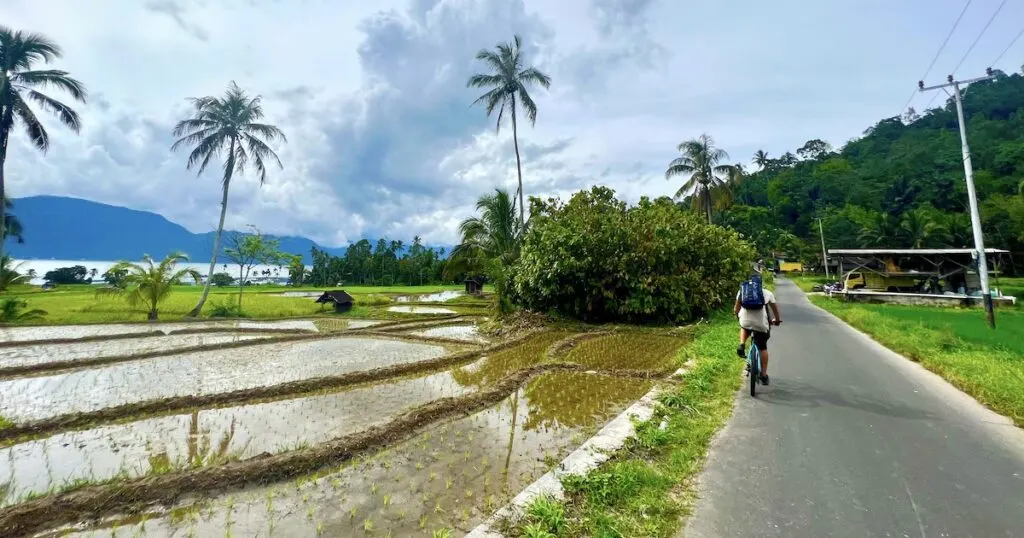
There are shops on the route, although they thin out on the western shore of the lake, where there are only small, remote villages.
The restaurants are mostly in the main villages on the north and west of the lake.
With plenty of stops for rests, refreshments, and chats with the villagers, cycling the entire lake should take you around 6 hours.
3. Visit Puncak Lawang for the best views over the crater
I adored visiting the Puncak Lawang viewpoint so much that I gave it its very own blog post. The birds-eye view is truly spectacular.
From the hills above the lake, you can get a sense for the full magnitude of the lake and admire the belt of fruit trees around the top of the crater too.
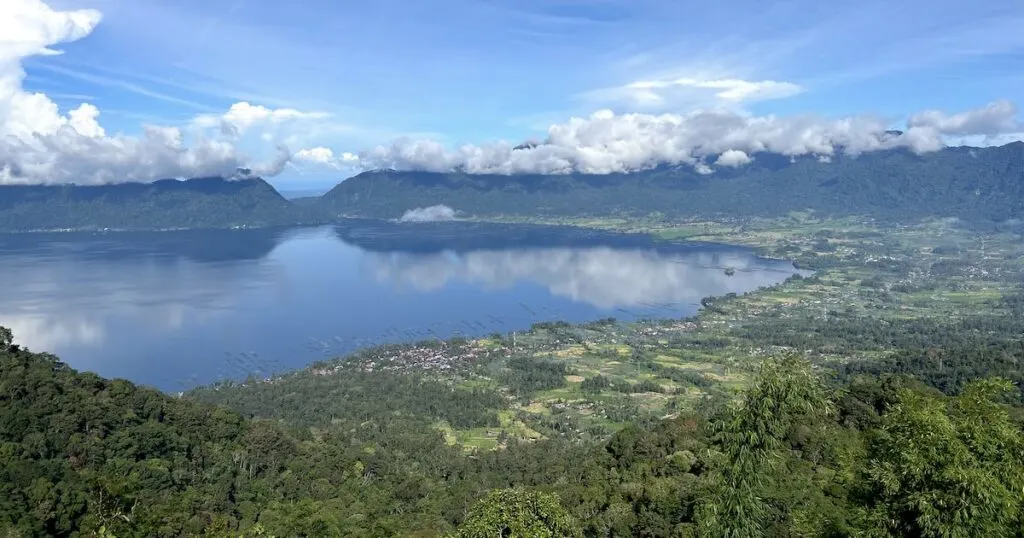
Puncak Lawang is half an hour’s drive from Maninjau village, up past Kelok 44.
The hilltop site has been transformed into quite the tourist stop; it has a modern coffee shop with a terrace.
There are also opportunities for paragliding (if the team is on site and willing to do it).
🦧🌋 Don’t miss these experiences in Sumatra…
1. Overnight orangutan trekking (from Bukit Lawang or Medan) – likely to sell out! 🦧
2. Hike Mount Sibayak at sunrise (from Berastagi or Medan) 🌋
3. The famous five-day Mentawai tribe tour
4. Try palai rinuak
Palai rinuak is Maninjau’s most famous food. The small fresh fish is caught in the lake and traditionally fried and served with coconut and spices before being wrapped in a banana leaf.
Look out for the dish at the markets surrounding the lake.
It’s fairly expensive, so you may need to haggle for a good price. Dried fish can be taken away as a souvenir too.
5. Unwind at Linggai Park
There are lots of small, waterfront parks around the lake. Linggai Park is one of the best.
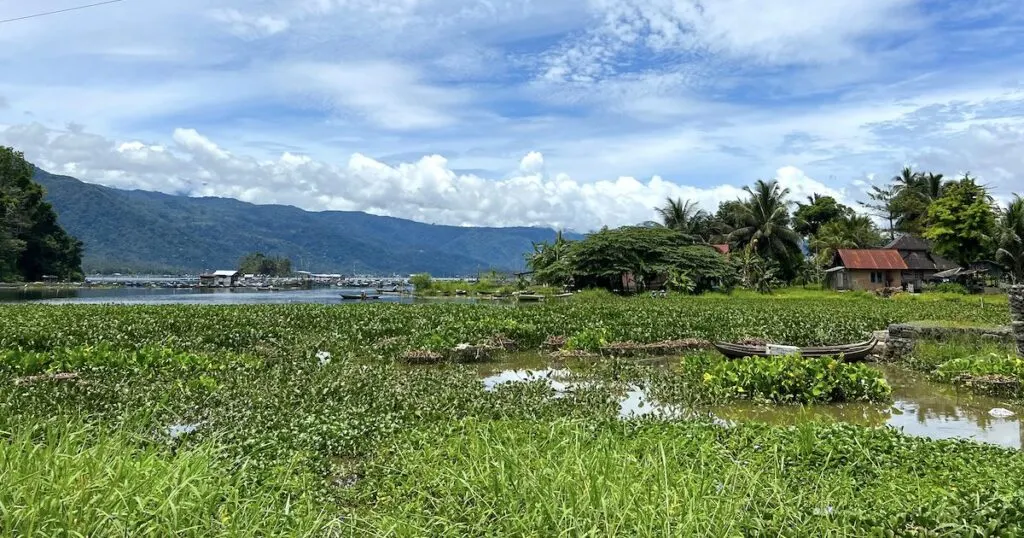
Just before the main tourist area, there’s a small collection of round benches overlooking a shallow bay where you can watch the fishing boats make their rounds in the morning.
6. Visit Bayur Central Mosque
The lake is surrounded by mosques of all different colours, shapes, and sizes.
The Bayur Central Mosque was the most impressive one I saw.
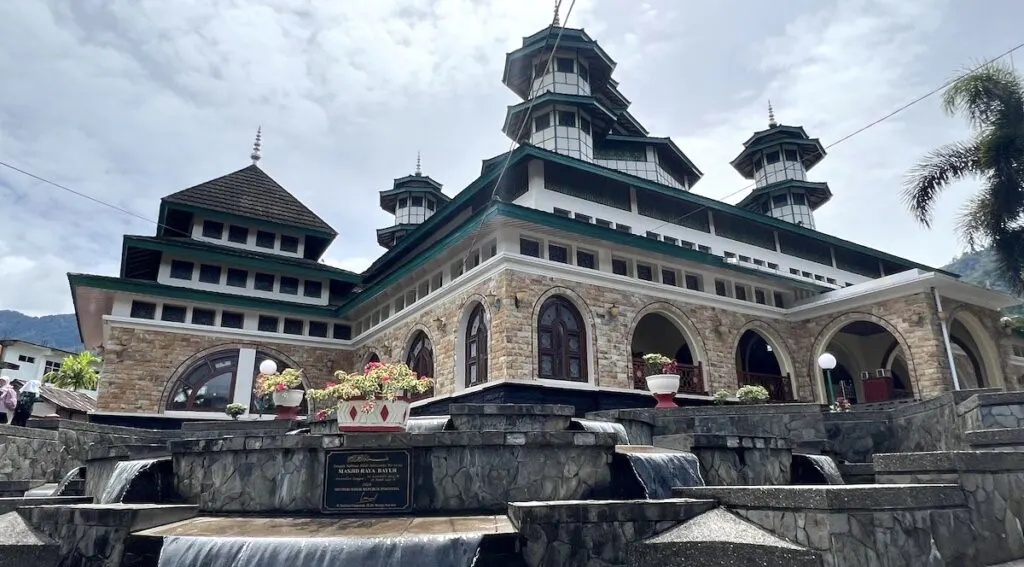
In the courtyard of the mosque, there is a tiered fountain, a fish pond, and areas for worshippers to carry out wudu (the washing before prayer).
7. Explore the villages on the western shore of Maninjau Lake
The western shore of Lake Maninjau is the remotest part of the crater, where most of the residents work in the fishing industry. Life seems to be simple and slow-paced.
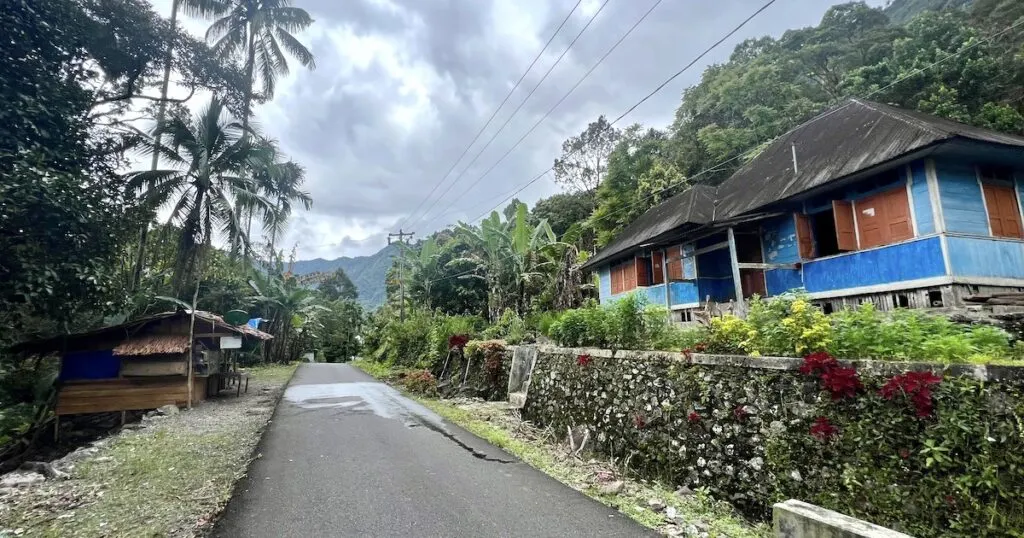
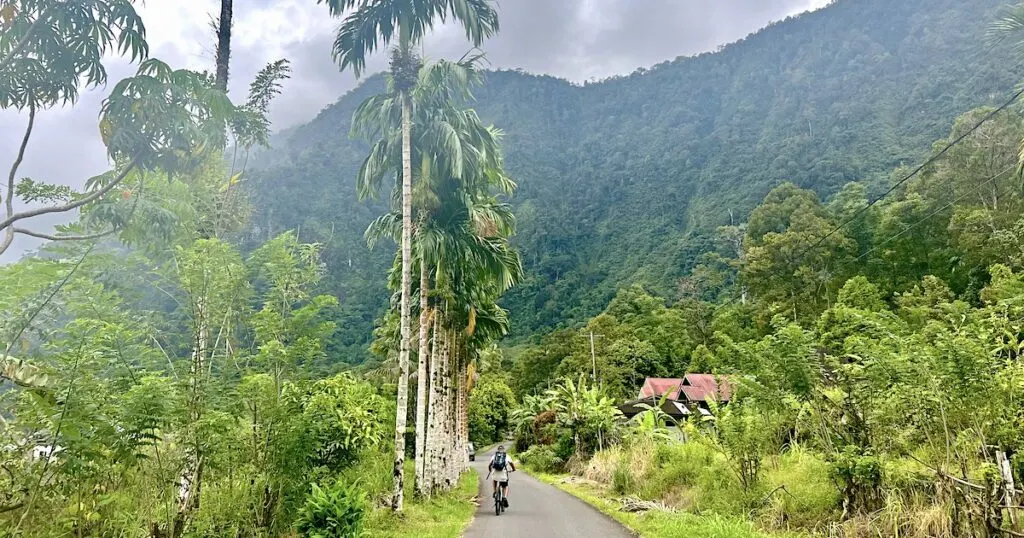
This side of the lake is the most scenic, in my opinion. There is a really steep section of the crater, which reminded me of Madeira in places.
The villages along this stretch are called Sungai Tampang, Sigiran, Muko Jalan, Batu Nanggai and Galapuang.
8. Visit Museum Rumah Kelahiran Buya Hamka
Museum Rumah Kelahiran Buya Hamka is the lake’s only museum.
Located in Pandan, it’s easy to cycle or scooter to.
The museum is based in the former home of Buya Hamka, an Indonesian Muslim novelist born in 1908.
The museum is therefore dedicated to his life and writings.
9. Go trekking
Jungle trekking tours can be arranged from Maninjau Lake.
They don’t take place within the crater, but rather around the area of Puncak Lawang and Sakura Hill.
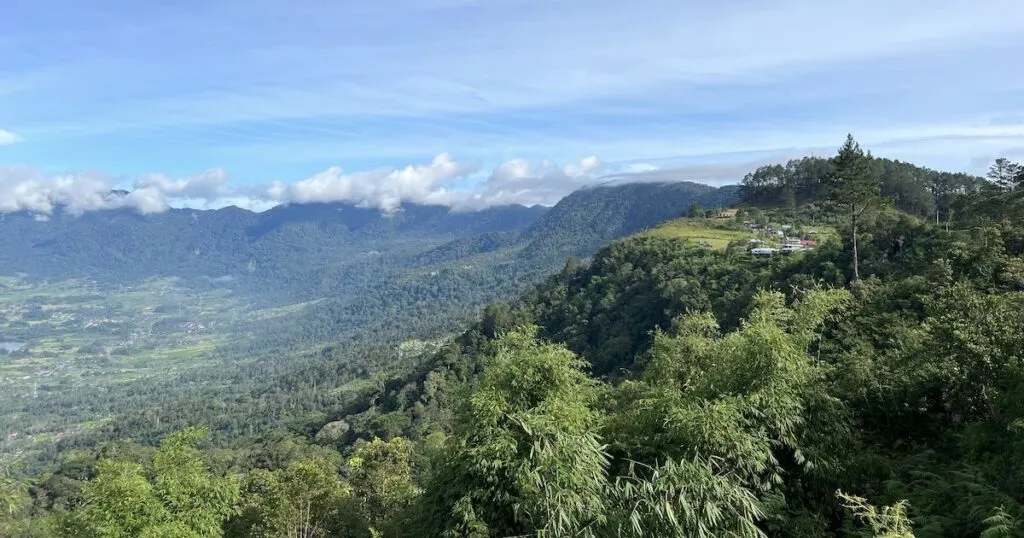
There used to be a trail from Maninjau village to the top of Puncak Lawang, but I’m not sure how accessible it is. These would be good questions to ask your guide.
10. Visit the hot springs
In the main village of Maninjau, there are hot springs called Aia Tigo Raso marked by a signpost
The springs are only small, but they are believed to have healing properties.
Places to Visit After Maninjau Lake
1. Bukittinggi
You have to go through Bukittinggi to get to Maninjau, but by no means should you pass through without staying for at least a night or two.
Bukittinggi has a large canyon with a ‘Great Wall’ on one side. There are also World War II tunnels, which are accessible for a small fee.

On top of that, this is one of the best places in Sumatra to try Minangkabau cuisine.
Check out the best things to do in Bukittinggi.
2. Harau Valley
If you liked Maninjau Lake, you will probably love the Harau Valley.
Located on the other side of Bukittinggi, the valley is a peaceful rural area with tall sandstone cliffs, waterfalls and impressive treks.

Harau Valley is brilliant for active breaks but just as good for relaxing and eating homecooked food at feel-good homestays.
Check out my Harau Valley travel guide.
3. Padang
Padang is the gateway to the Mentawai Islands, a surfing hotspot.
It’s also the largest city in west Sumatra and very well known for its food delicacies.
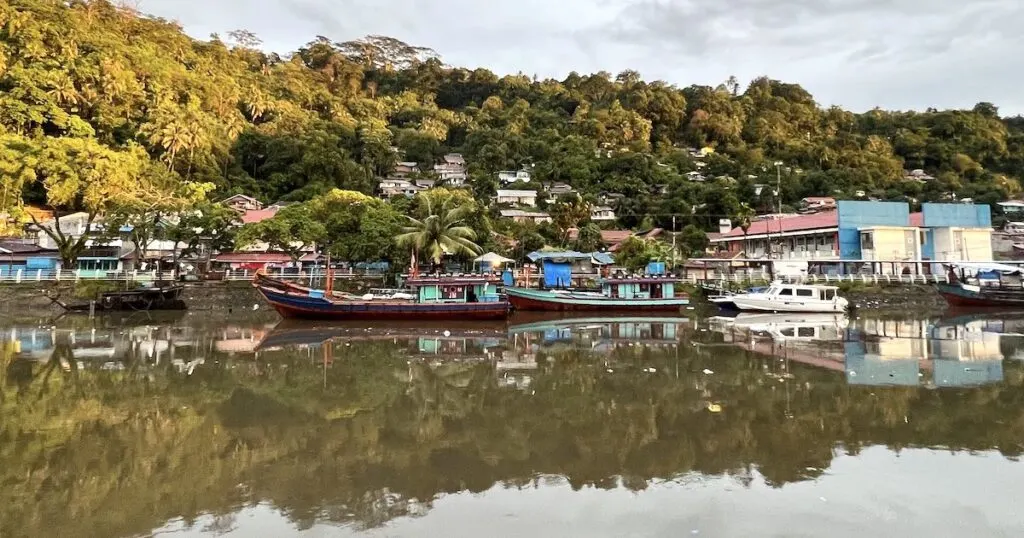
It has a Chinatown and several great sunset beaches.
I hope you found my guide useful! Feel free to leave a comment below with your experience at Maninjau Lake – I’d love to hear from you.

